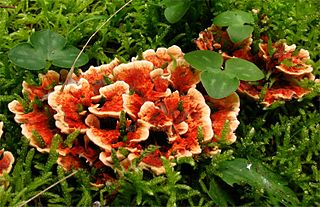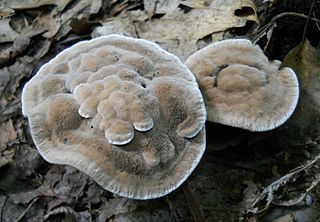
Hydnellum is a genus of tooth fungi in the family Bankeraceae. Widely distributed in the Northern Hemisphere, the genus contains around 40 species. The fruitbodies of its members grow by slowly enveloping nearby bits of grass and vegetation. There is great variability in the form of Hydnellum fruitbodies, which are greatly influenced by environmental conditions such as rainfall and humidity, drying winds, and temperature. They are too tough and woody to eat comfortably. Several species have become the focus of increasing conservation concern following widespread declines in abundance.

Sarcodon is a genus of fungi in the family Bankeraceae, which is part of the order Thelephorales, known for its almost universal ectomycorrhizal ecology. The genus owes its name to the presence of teeth-like spines on the hymenophore, from ancient Greek; sarco = flesh and odon = tooth. For this reason they are commonly called "tooth fungi", or "Hydnoid fungi".

The hydnoid fungi are a group of fungi in the Basidiomycota with basidiocarps producing spores on pendant, tooth-like or spine-like projections. They are colloquially called tooth fungi. Originally such fungi were referred to the genus Hydnum, but it is now known that not all hydnoid species are closely related.

Hydnellum fuscoindicum is a species of tooth fungus in the genus Hydnellum. It is found in the Pacific Northwest in moss around western hemlocks. It produces fruit bodies with a violet-black cap, violet flesh, and violet spines on the cap underside. The odor and taste are very farinaceous. The fungus was first described by Kenneth A. Harrison in 1964 as a species of Hydnum, then transferred to Sarcodon in 1967 by Rudolph Arnold Maas Geesteranus. He placed this species in section Violacei of Sarcodon, along with H. fuligineoviolaceum and H. joeides.

Hydnellum auratile is a tooth fungus in the family Bankeraceae. Fruit bodies of the fungus consist of closely grouped, funnel-shaped caps up to 5 cm (2.0 in) in diameter. The caps are initially bright orange with a white rim, and have a felt-like surface. On the cap underside, the hymenium has hanging orange spines with whitish tips. These spines extend a ways down the length of the short stipe. The flesh is orange in both the cap and stipe. In mass, the spores are brown. Microscopically, they measure 4–5 by 3.5–4.5 µm and have short, rounded tubercles on the surface. The widespread Hydnellum aurantiacum is a close lookalike, but can be distinguished by having a white to buff cap, dull orange to brown flesh, and white spines.
Hydnellum nigellum is a tooth fungus in the family Bankeraceae. Found in Nova Scotia, Canada, where it grows under spruce, it was described as new to science in 1964 by Canadian mycologist Kenneth A. Harrison. The fruitbodies of this fungus are small, measuring 3–6 cm (1.2–2.4 in) in diameter, and black.
Hydnellum fraudulentum is a tooth fungus in the family Bankeraceae. Found in Australia, it was described as new to science in 1971 by Dutch mycologist Rudolph Arnold Maas Geesteranus from collections made in Victoria.
Hydnellum papuanum is a tooth fungus in the family Bankeraceae. Found in Papua New Guinea, it was described as new to science in 1971 by Dutch mycologist Rudolph Arnold Maas Geesteranus.
Hydnellum staurastrum is a tooth fungus in the family Bankeraceae. Found in Malaysia, it was described as new to science in 1971 by Dutch mycologist Rudolph Arnold Maas Geesteranus.
Hydnellum crustulinum is a tooth fungus in the family Bankeraceae. Found in Punjab, India, it was described as new to science in 1971 by Dutch mycologist Rudolph Arnold Maas Geesteranus.
Hydnellum tardum is a tooth fungus in the family Bankeraceae. Found in Europe, it was described as new to science in 1975 by Dutch mycologist Rudolph Arnold Maas Geesteranus, from collections made in coniferous forest in what was then known as West Germany.
Hydnellum singeri is a tooth fungus in the family Bankeraceae. Found in Colombia, it was described as new to science in 1969 by Dutch mycologist Rudolph Arnold Maas Geesteranus. The specific epithet honors Rolf Singer.

Hydnellum spongiosipes, commonly known as the velvet tooth, is a tooth fungus in the family Bankeraceae. It is found in Europe and North America. In Switzerland, it is considered a vulnerable species.

Hydnellum glaucopus is a species of tooth fungus in the family Bankeraceae. Found in Europe, it was described as new to science in 1969 by mycologists Rudolph Arnold Maas Geesteranus and John Axel Nannfeldt. Fruit bodies contain cyathane diterpenes called glaucopins that have anti-inflammatory activity in laboratory tests. It is considered vulnerable in Switzerland.
Hydnellum lundellii is a species of tooth fungus in the family Bankeraceae. Found in Europe, it was described as new to science in 1969 by mycologists Rudolph Arnold Maas Geesteranus and John Axel Nannfeldt.

Hydnellum fuligineoviolaceum is a species of tooth fungus in the family Bankeraceae. It was originally described in 1874 by Hungarian mycologist Károly Kalchbrenner as Hydnum fuligineoviolaceum, in Elias Fries's work Hymenomycetes europaei. Narcisse Théophile Patouillard transferred it to the genus Sarcodon in 1900. Sarcodon talpa, published by Rudolph Arnold Maas Geesteranus in 1967, is a synonym.
Hydnellum lepidum is a species of tooth fungus in the family Bankeraceae. Found in Europe, it was described as new to science in 1975 by Dutch mycologist Rudolph Arnold Maas Geesteranus.

Hydnellum martioflavum is a species of tooth fungus in the family Bankeraceae, found in Europe and North America.

Hydnellum joeides is a species of tooth fungus in the family Bankeraceae.
Mycorrhaphium pusillum is a species of tooth fungus in the family Steccherinaceae. It is a rare European fungus that has only been officially recorded a few times.









